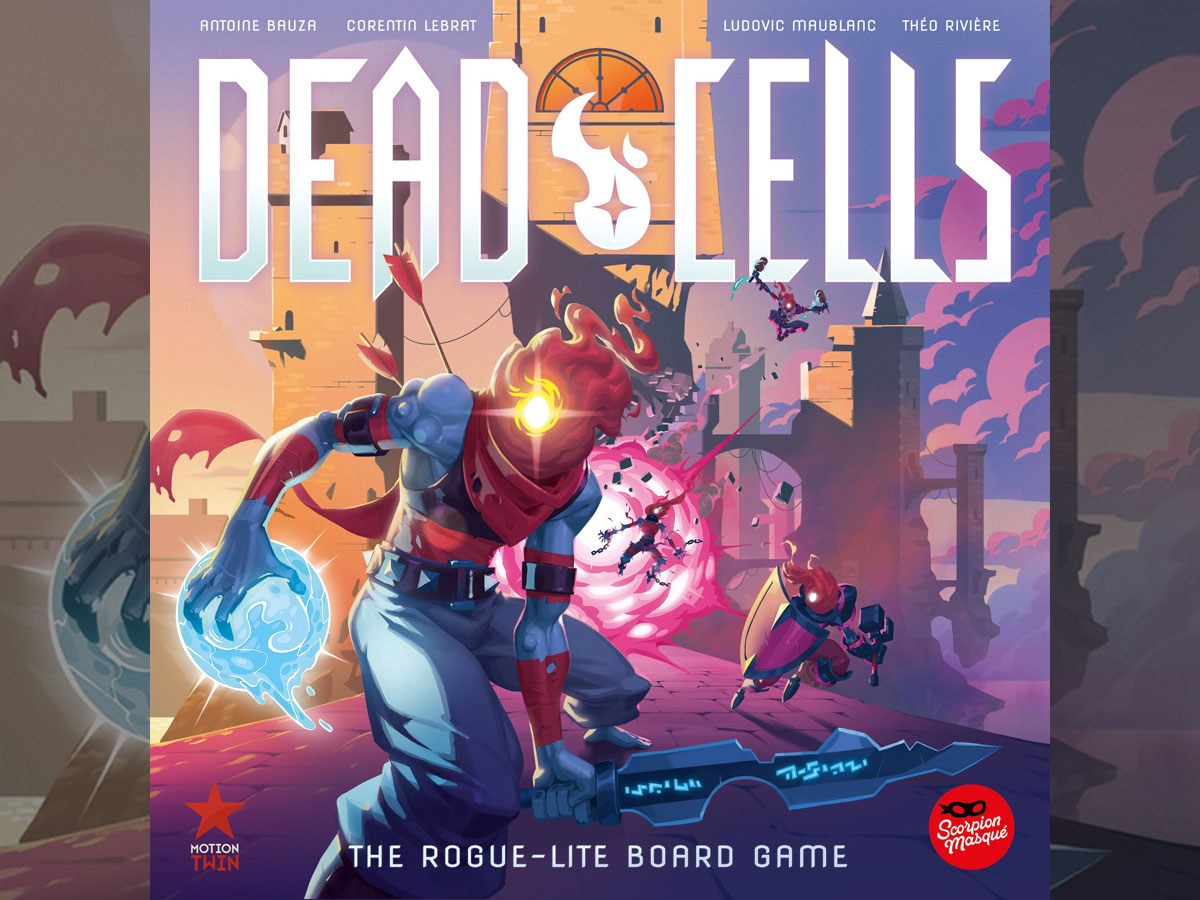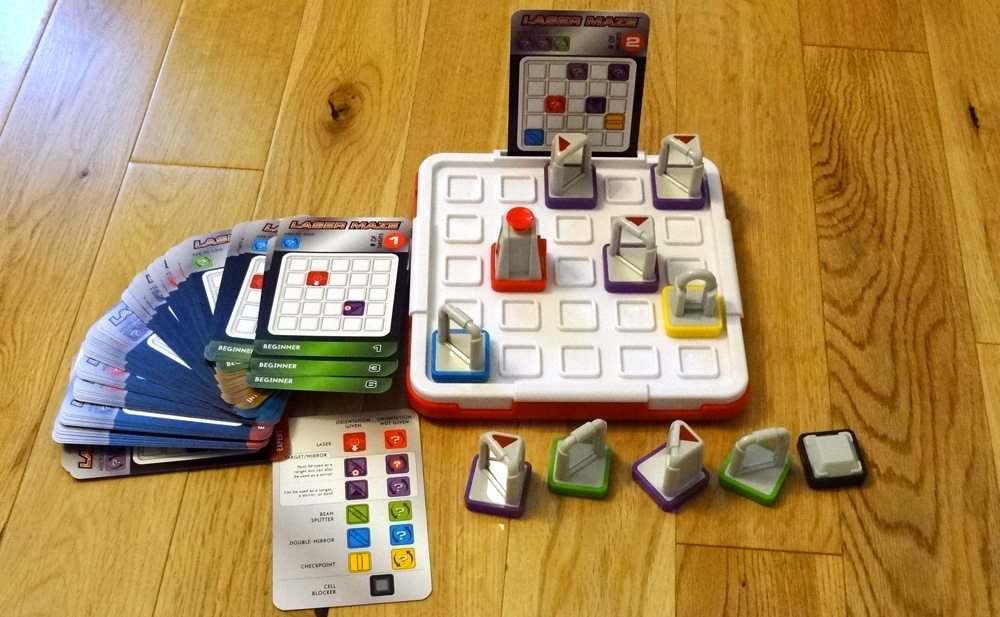The bad news: you’re dead. The good news: somehow, that doesn’t stop you from exploring this weird dungeon and trying to battle your way out.
In “Reaping the Rewards,” I take a look at the product of a crowdfunding campaign. Dead Cells: The Rogue-Lite Board Game was originally funded through Kickstarter in June 2023. It has since been delivered to backers, and the retail edition was just released last week.
What Is Dead Cells: The Rogue-Lite Board Game?
Dead Cells: The Rogue-Lite Board Game is a cooperative game for 1 to 4 players, ages 14 and up, and takes about 45 minutes to play per session. It retails for $89.99 and is available now directly from Hachette Boardgames USA or at your local game store. The game is based on the Dead Cells video game and involves a lot of combat and you play as the Beheaded, characters who have been executed; if you are okay with some cartoony video game–style violence, then you may be able to play with younger kids as well, though there are some complexities with the rules as well. While you don’t need to be familiar with the video game to play the board game version, it does help give you a better sense of the setting and storyline.
Dead Cells: The Rogue-Lite Board Game was designed by Antoine Bauza, Corentin Lebrat, Ludovic Maublanc, and Théo Rivière and was published by Scorpion Masqué, with illustrations by Laure de Chateaubourg, Xavier Gueniffey Durin, Robin Lagofun, Paul Vérité. It is distributed in the US by Hachette Boardgames USA, which provided a pre-production copy for this review.
What Is “Rogue-Lite”?
Before we get too far into Dead Cells itself, it’s probably worth touching on the term “rogue-lite.” The term comes from a 1980 computer game called Rogue, which was a dungeon crawl through procedurally generated rooms. If your character died, you had to start the game over—no extra lives like Pac-Man or Mario. The term “rogue-like” was used for games that shared similar features, but then the term “rogue-lite” was coined for games that also used a few of these but started to branch off in different directions. The Dead Cells video game does use procedurally generated levels so the maps are different each time you play, but the level types (known as biomes) always come in the same order. When you die, you have to start at the beginning again, but there are upgrades you can gain that will now be unlocked already: runes give you permanent new abilities, and weapons that you’ve acquired in previous runs will also become available for future runs.
The board game version of Dead Cells expands the game from a single-player platformer to a cooperative turn-based combat game, but it keeps the concepts of randomized levels (though not quite as random as what is possible in a video game) and permanent upgrades that you collect as you play through the levels, die, and repeat.
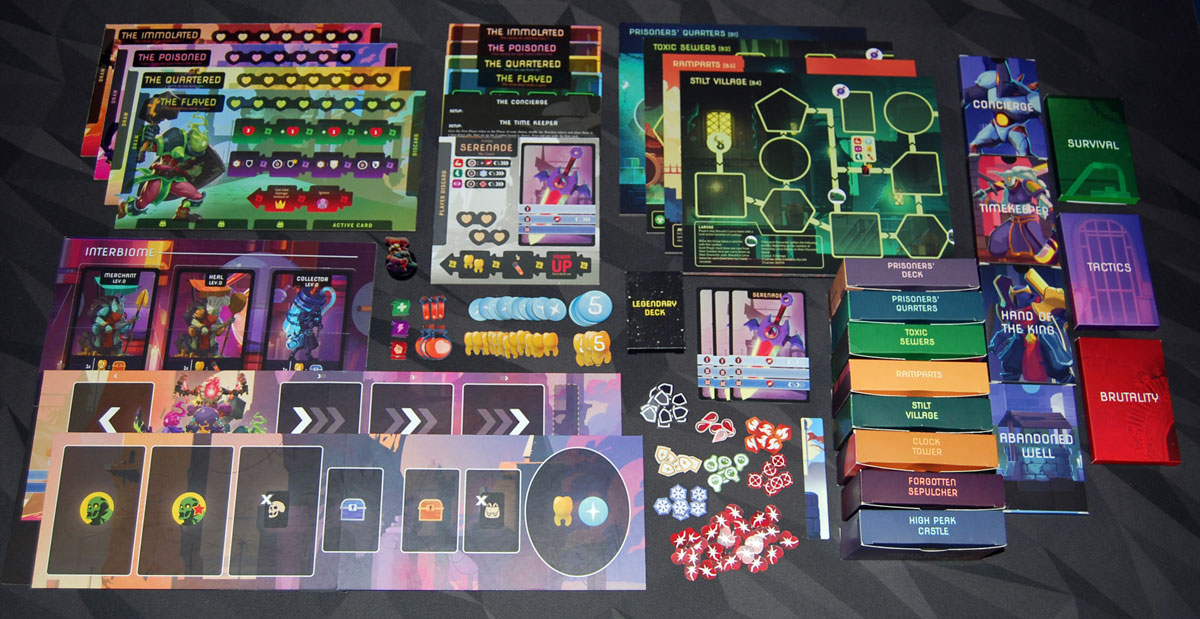
Dead Cells: The Rogue-Lite Board Game Components
Note: My review is based on a pre-production copy, so it is subject to change and may not reflect final component quality. This copy did not include all of the content for the entire campaign. My copy had a mix of components from the basic and deluxe (Kickstarter) editions.
Here’s what comes in the standard edition:
- 4 Player boards
- 4 Player aids
- 3 Boss Reference sheets
- Solo board
- 4 Biome boards (double-sided)
- Mutation board
- Combat board
- Annex board
- 4 Beheaded standees with group base
- Loot tokens
- Combat tokens
- Status tokens
- 7 Biome sets
- 3 Boss sets
- Upgrade cards (Survival, Tactics, and Brutality)
The Biome sets include various cards and tokens depending on the specific biome—enemy cards, equipment cards, and large tokens that are used to fill out the maps. In the deluxe edition, each biome has its own tuckbox as pictured above, but the retail edition provides divider cards and you just sort them out in the box insert. The other main difference between the retail and deluxe edition is that the deluxe includes a plastic miniature instead of the standees, some fancier tokens, and a few more additional secret cards, but the bulk of the content is otherwise the same.
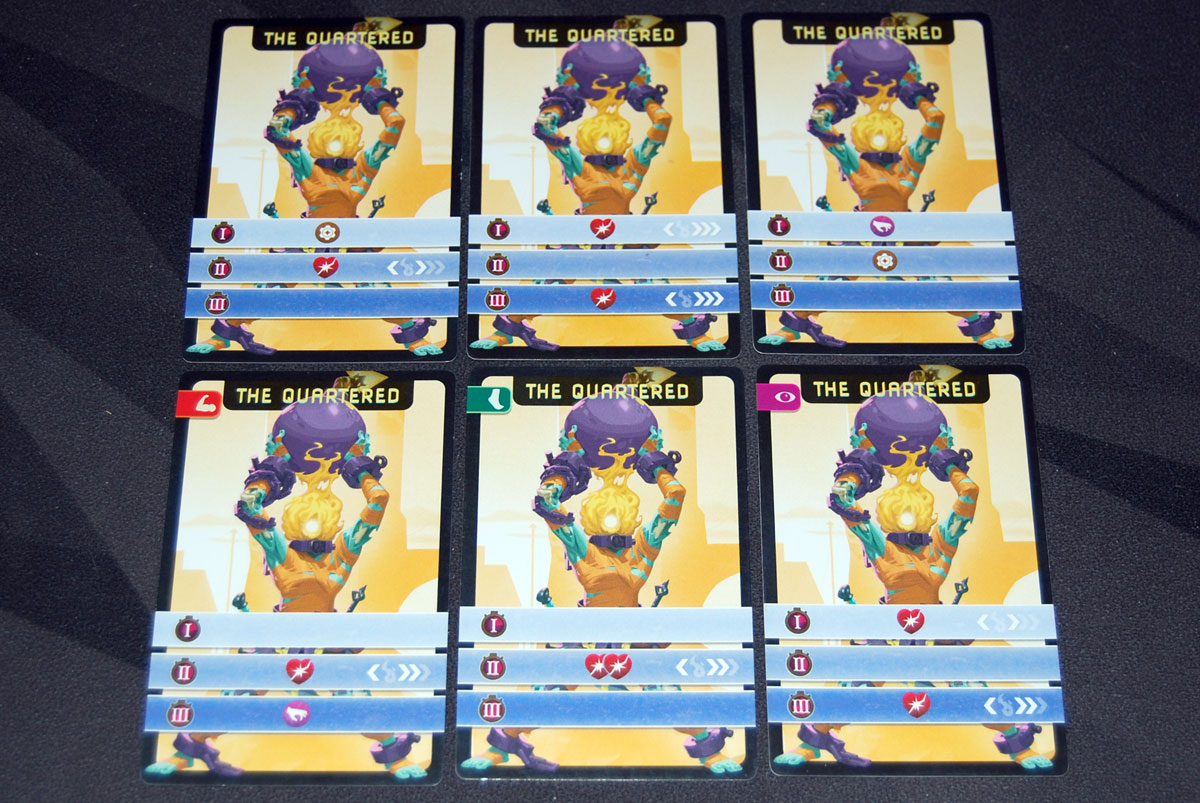
As you can see, there’s a lot of stuff in the box—I won’t go into detail about all of the components since I’ll show more of that in the gameplay section. The game uses a mix of extra-large cards for the action cards and upgrades, and some small cards for things like equipment and the runes that you’ll collect. While the video game has a pixel art look for the game itself, the cover art style has been carried over into the board game. The main characters are the Beheaded, with a ball of flame in place of their heads—in the board game, there are four of them with names that hint at how else they were executed: Quartered, Immolated, Flayed, and Poisoned.
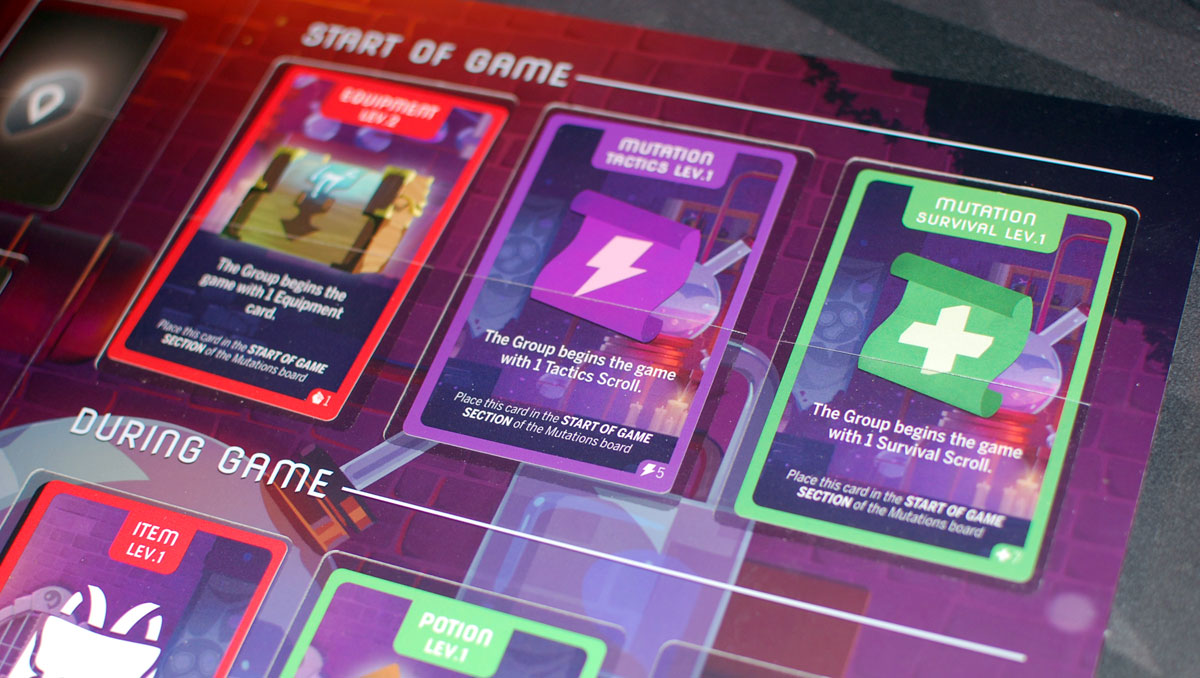
The mutation board, which is the largest main board, has a special feature: it’s dual layered with cut-outs for the various cards that will be placed there, but those cut-outs also have transparent pockets built in so that you can tuck cards into them and store them even when you put the game away. That’s to enable the rogue-lite nature of the game, where you play until you “die,” but are able to acquire upgrades that carry over to your next session. Part of the board has all the small rune cards, which start face-down but get flipped when you find them—once you’ve collected a rune, it stays face-up in its pocket for the entirety of the campaign.
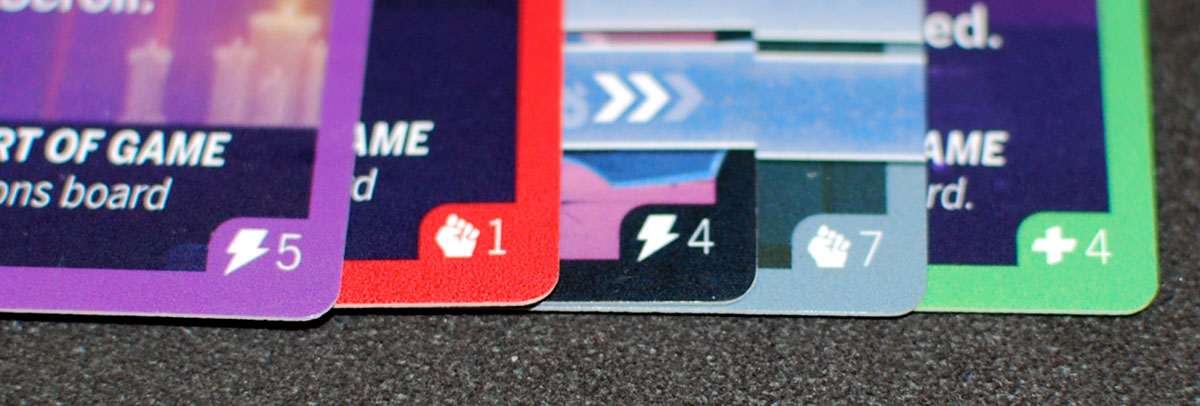
As you play through the campaign, you’ll add cards from the three upgrade decks, and you’ll also mix in new item cards into the equipment deck. The cards have handy index numbers on them so that when you’re done, you can reset the game back to its original state to play again.
How to Play Dead Cells: The Rogue-Lite Board Game
You can download a copy of the rulebook here.
The Goal
The goal of the game is to make it as far through the dungeon as you can, and also level up your characters and gain new abilities each time through the dungeon. There is a set number of levels and a final boss at the end, but even after beating the boss you can continue to play and explore.
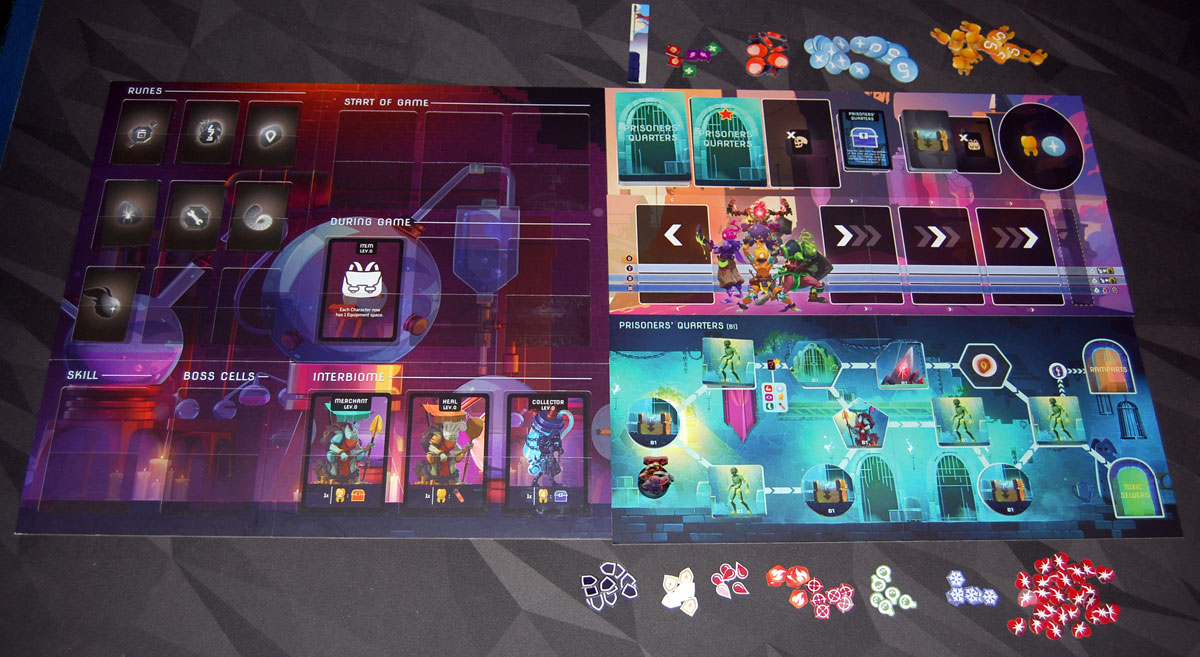
Setup
Set out the mutation board, the annex board, and the combat board—these remain on the table throughout the game. When you first start the game, the mutation board will be mostly empty: all of the small rune cards should be tucked in face-down, and all the other slots are empty (though a few have cards pre-printed in them, like the Level 0 Item slot). Place the upgrade decks and Well deck nearby—do not shuffle these! Make a supply of the various tokens. Place the equipment deck on the annex board.

Set up the current biome (you begin in the Prisoner’s Quarters). Place the biome board, and then find the corresponding tiles and shuffle them up and place them on the map in the corresponding spaces: squares are enemies, hexagons are encounters, pentagons are markets, and circles are treasures. The square with a cut corner is an elite enemy. Place the character standee at the starting space. Shuffle the enemy decks and the blueprint cards for the biome and place them on the biome board.
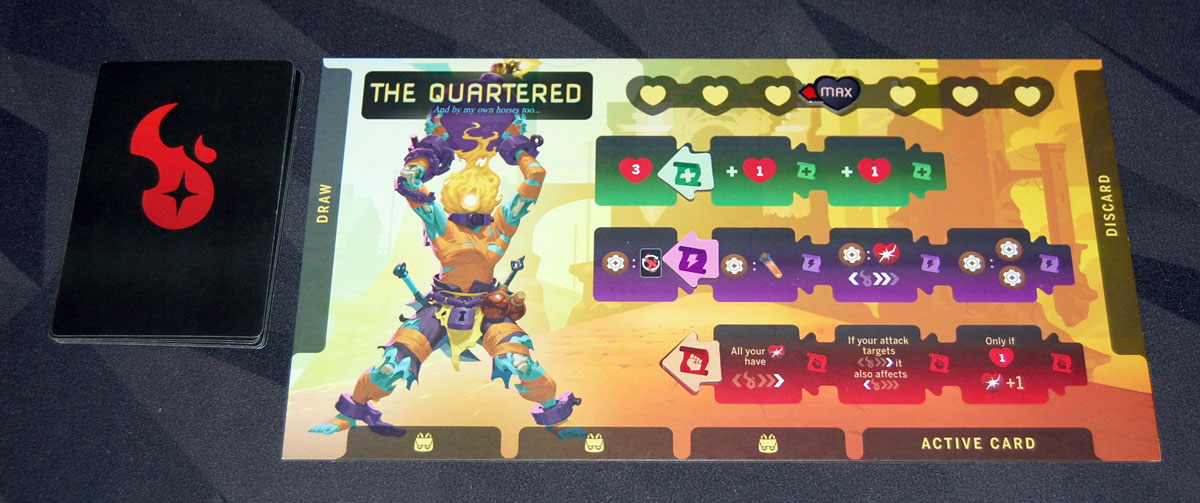
Each player gets a player board and the corresponding deck of cards. Take a max health marker and place it so that you have room for 3 damage tokens to the left. Place your three scroll markers on the leftmost spaces: your current ability levels are to the left of those markers. (For instance, for the Quartered player shown above, the Survival skill gives them 3 health, the Tactics skill lets them use the gear action to copy a combat action from their discard, and the Brutality skill does not offer any abilities until it is upgraded at least once.)
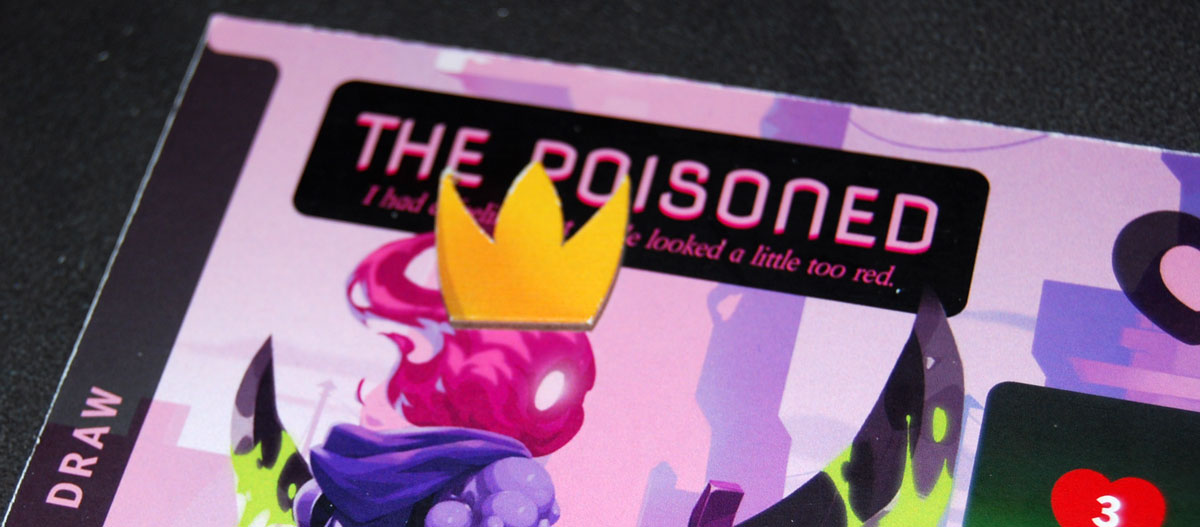
Choose a player to be the first player, and give them the crown token (which can be placed on the character portrait on your board).
Everyone shuffles their own deck of cards and draws a hand of 3 cards.
Gameplay
Each turn, you decide as a group where to move along the path, then reveal the tile there and resolve it, whether it’s gaining some treasure or entering combat or something else. If you survive, then you get to continue moving. Some paths have a skill check: the player with the crown discards a card from their deck, and if it has the right symbol on the top left, then the group passes the check and can continue; otherwise, you’ll have to choose a different path or suffer a penalty.
The bulk of the game will be when you enter combat. The enemy tile will show how many enemy cards to draw—elite enemies are marked with a star. Generally, cards are placed in the first two spaces to the right of the characters on the combat board, but some enemies will have other starting locations marked (using the arrow icons to indicate the four possible locations). The enemy tile may also show some loot, which is placed on the character portrait of the combat board.
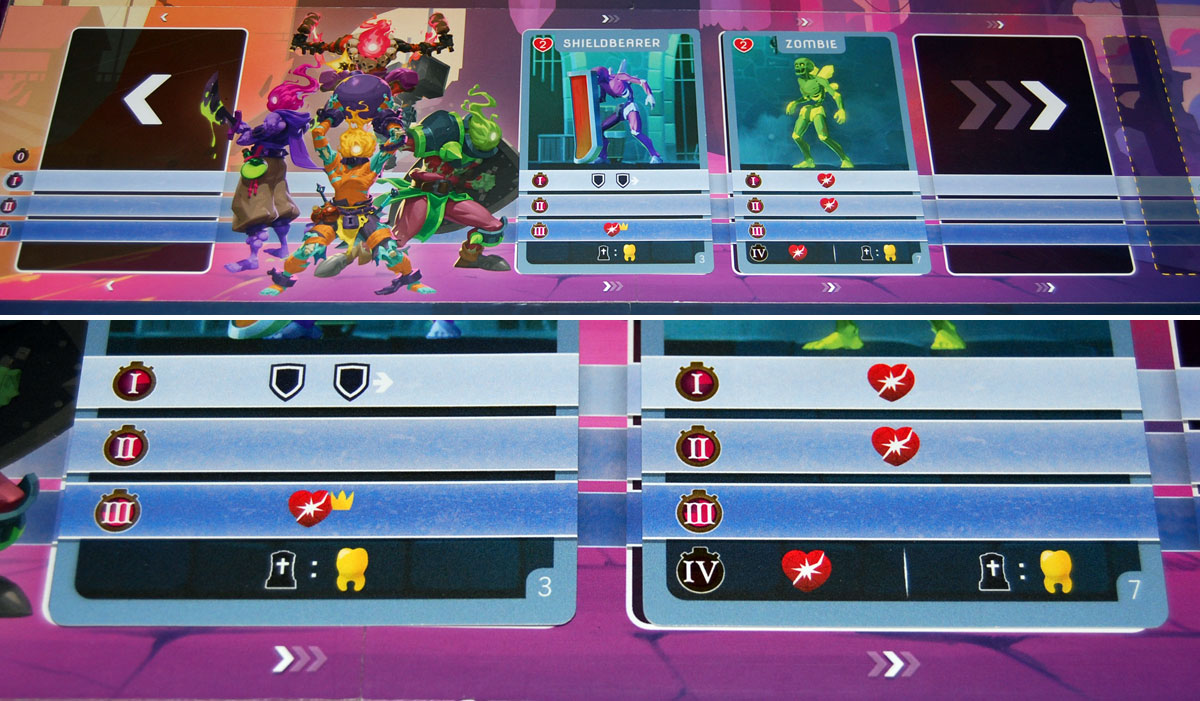
Each enemy card has three rows across the bottom that show what it will do over the course of a 3-round combat. At At the bottom of the card, there’s also the reward for killing that enemy. (In some cases, as in the zombie shown above, there’s a 4th round action: this zombie does one more damage if it escapes.)
As a team, players discuss tactics briefly. You are allowed to discuss priorities like which enemy to attack first, but you cannot reveal what’s specifically on your own cards. Regardless of player count, you will always play 3 cards as a team. If you have 4 players, the 4th player will get a chance to upgrade but will not participate in the combat otherwise. Once everyone has chosen their card(s), the cards are revealed.
Combat is resolved one row at a time, going across the combat board. Enemies in the left space will activate first, then the players will activate their Round 1 actions in turn order, and then up to three more enemies to the right. Note that you do not play any more cards—the same card is used for all three rounds!
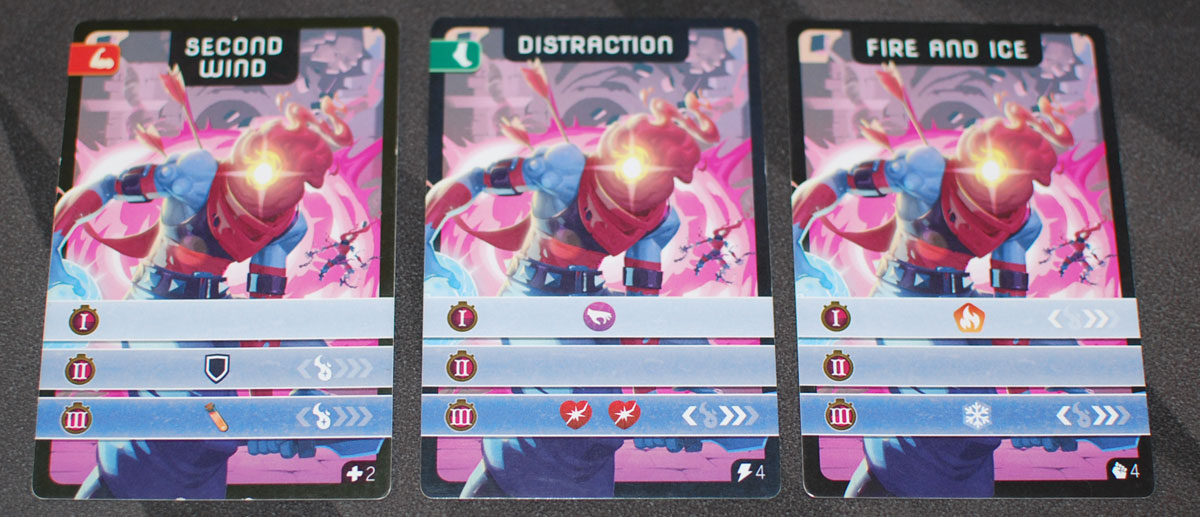
Actions will include things like doing damage, adding status effects, and grabbing loot. Attacks will specify which of the four enemy spaces you can hit with them, so you have to match up your attacks with where the enemies are located. Some combat cards also show a gear icon: that means you can activate an unlocked gear action on your player board or an equipment card with a gear icon. Status effects include things like shields to prevent damage, poison (which causes one damage at the end of each combat round), and freeze to prevent an enemy from acting.
If you kill a monster, get the loot shown at the bottom of its card and discard it; at the end of the combat round, monsters will advance to fill in the spaces.
At the end of the 3 rounds, any monster with a Round 4 action performs it and is then discarded. Any looted scrolls and equipment are divvied up among the players who were in combat: scrolls let you advance your scroll marker on your player board, upgrading your abilities; equipment is placed in the slots below your player board, but at the beginning of the game you are limited to 1 slot per player. Cells and gold teeth (which serves as money in Dead Cells) are placed in the “bag” space of the annex board.

If you make it all the way to an exit on the biome map, then you get to visit the Interbiome, where three mysterious figures will sell you their wares: the Merchant sells you equipment, the Healer removes damage, and the Collector lets you buy more blueprints to put into the equipment deck. Then it’s off to the next biome!
Every so often, you will also encounter bosses, which are more complex combats with their own specific rules.
Game End?
If any player dies in combat, the run will end (after finishing the combat). But it’s not completely over: this is where you get to spend those cells you collected!
Discard everything in your bag except the cells. Any equipment cards that players have are shuffled into the equipment deck, but blueprint cards that have not been purchased from the Collector go back to the blueprint deck. Reset all of your scroll trackers on your player board to the starting location. Awww, you’re back at level 1.
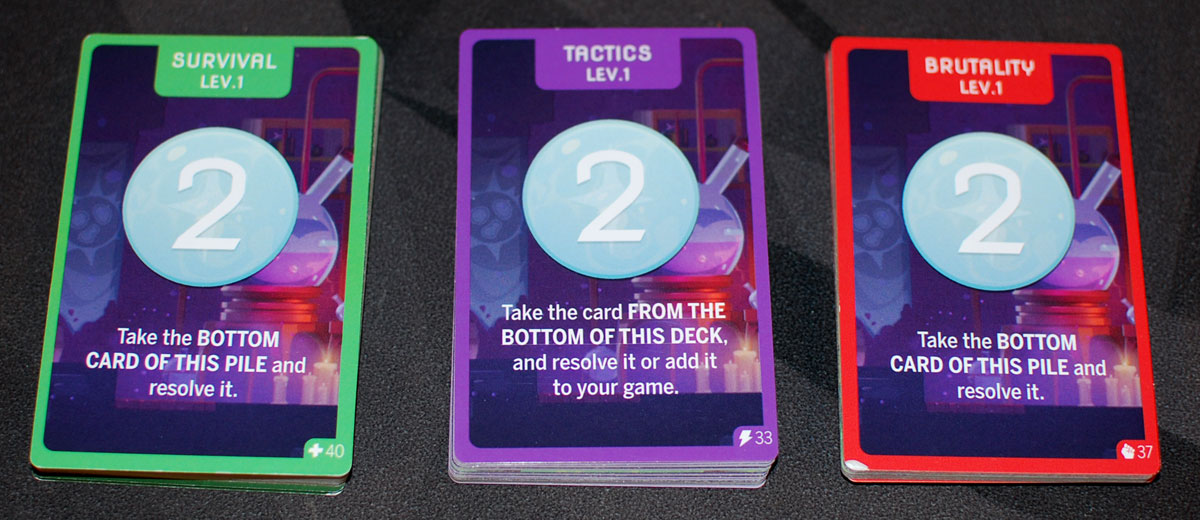
You may spend your cells to buy cards from the three upgrade decks: Survival, Tactics, and Brutality. At the start of the campaign, each card will cost 2 cells—you draw the card from the bottom of the deck and resolve it. There are a number of possibilities: new combat cards that can be added to a player’s deck, mutations that are added to the mutation board as permanent upgrades, and even new enemy cards that are added into a particular biome. Feat cards will give you a specific task to accomplish during a run, like an achievement—if you complete a feat, you’ll get a reward.
The mutation board has a limited number of slots for mutations, though, so each time you do a run, you’ll have to decide which mutations to use. Some give you bonuses at the beginning of the game (like getting one free scroll upgrade or starting with an equipment card) and some have ongoing bonuses (like unlocking an extra equipment slot).
There’s one other spot to spend your cells: the abandoned well. It only costs 1 cell, so it’s a good place to put your odd cell once you’re done buying things. What does it do? Well, you’ll just have to throw some cells in there to find out.
Okay, you’ve gotten some upgrades—time to respawn and start again!
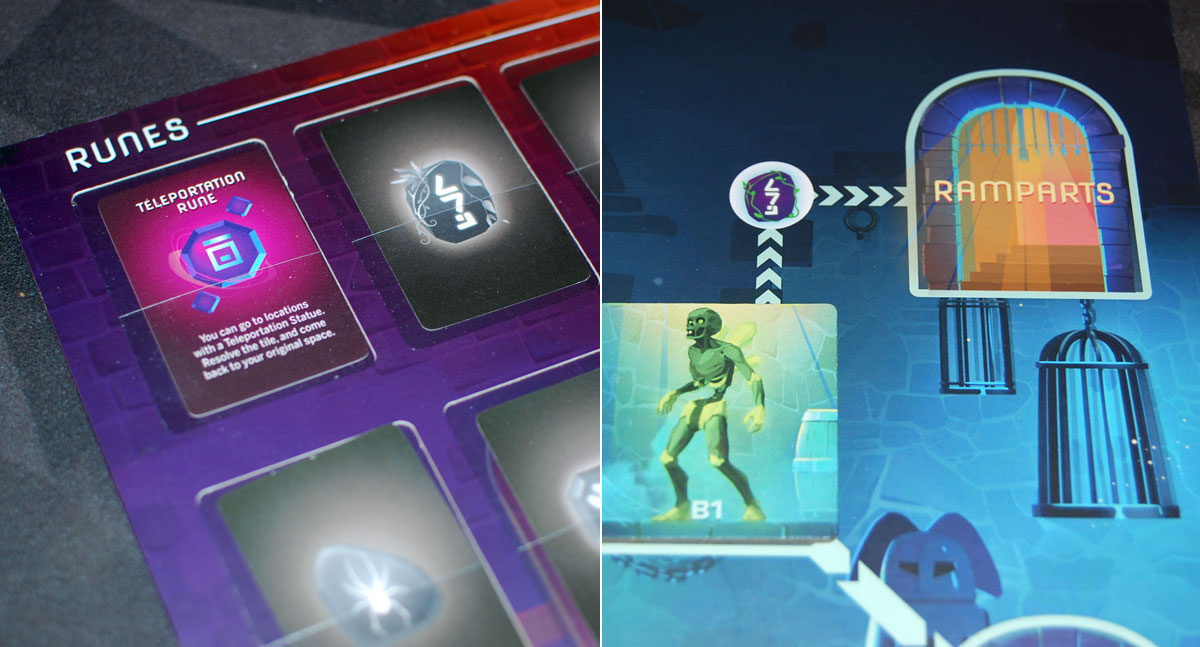
Why You Should Play Dead Cells: The Rogue-Lite Board Game
When the Kickstarter campaign for Dead Cells launched back in May 2023, I actually hadn’t played the video game at all, and I didn’t really know much about it except that it was pretty popular—enough to raise over a million dollars. I was familiar with some of the other tabletop games designed by the team, particularly those of Antoine Bauza, and I’ve also been a fan of many of Scorpion Masqué’s titles, so it felt like it had a pretty good pedigree, but with emotional connection to the theme I didn’t really pay a lot of attention to it at the time.
Not too long after that, though, it became available on the Xbox Game Pass so I decided to give it a shot. I tried it, and got hooked immediately: I liked the way that the world gradually opens up as you acquire runes that give you access to new paths, and how you unlock new abilities over the course of many runs through the dungeon. While the different biomes are linked to each other in consistent ways, each specific map is new each time, keeping it fresh for new exploration. There’s also a lot of humor in the game—despite the fact that it’s largely running around slashing at enemies, there are also weird little encounters with funny dialogue, to which your character responds with gestures because, well, you have no actual head.
Dead Cells: The Rogue-Lite Board Game manages to take a lot of that discovery and exploration and humor and translates it into an entirely different format. It can be hard to turn an action-based video game into a board game, and I had wondered how they would make a solo platformer into a game for multiple players. The combat system doesn’t feel exactly like playing the video game, but it makes for a good puzzle: you can see exactly what each enemy is going to do each round of combat, so then it’s about figuring out the best approach. Should you attack the Grenadier that will hit everyone at once in round 3? Or are you better off taking out the Shieldbearer before it shields itself up and is harder to hit? Is anyone going to be able to pick up the loot this turn?
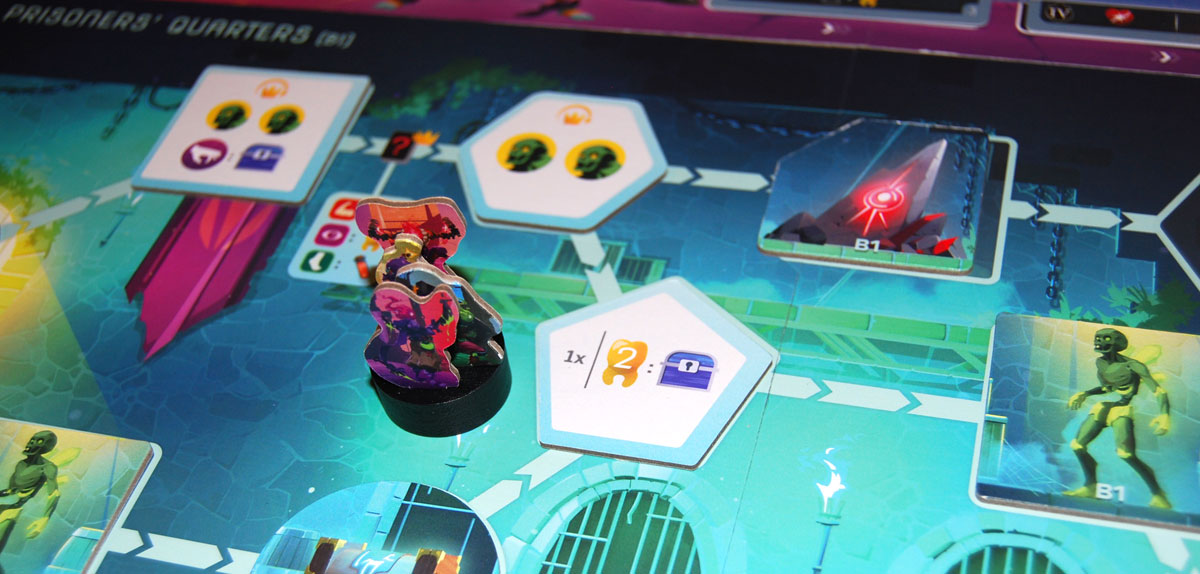
One thing that I think is very hard to capture in board game form is the fast pace of the video game: instead of running around and hitting buttons, fighting hordes of enemies in one level, you may face something like six enemies in a biome, because each combat can take a good amount of time to complete in the board game. A lot of this will depend on how quickly your gaming group can decide on things, and how much they stick to the limited communication rules. The rulebook does have a note that you’re in the middle of combat so any discussion needs to be brief, but there isn’t a strict time limit, and I know I’ve taught games where players spent a solid several minutes discussing who would play cards. If you’re okay with a longer play time then that’s not a huge issue, but if you want to hit that 45 minutes listed on the box, you have to be a lot snappier!
The four characters in the board game are asymmetric, allowing for different approaches. The Immolated has the ability to burn enemies—if you can get 2 fires on the same monster, it dies immediately. The Poisoned can gain immunity to poison and can also inflict poison, which does damage at the end of each combat round. The Quartered has more flexibility in the locations it can attack, and also has a very powerful gear combination action. The Flayed is the tank, with a higher maximum health and the ability to gain shields to soak up more damage. It’s fun to see the ways that the four different characters behave and interact with each other. The downside is that it does feel like the game is designed ideally for 3 players: you each get to play one combat card, and nobody sits out. I’ve run several 4-player games, and while it does work, I think I like it at 3 players the most.
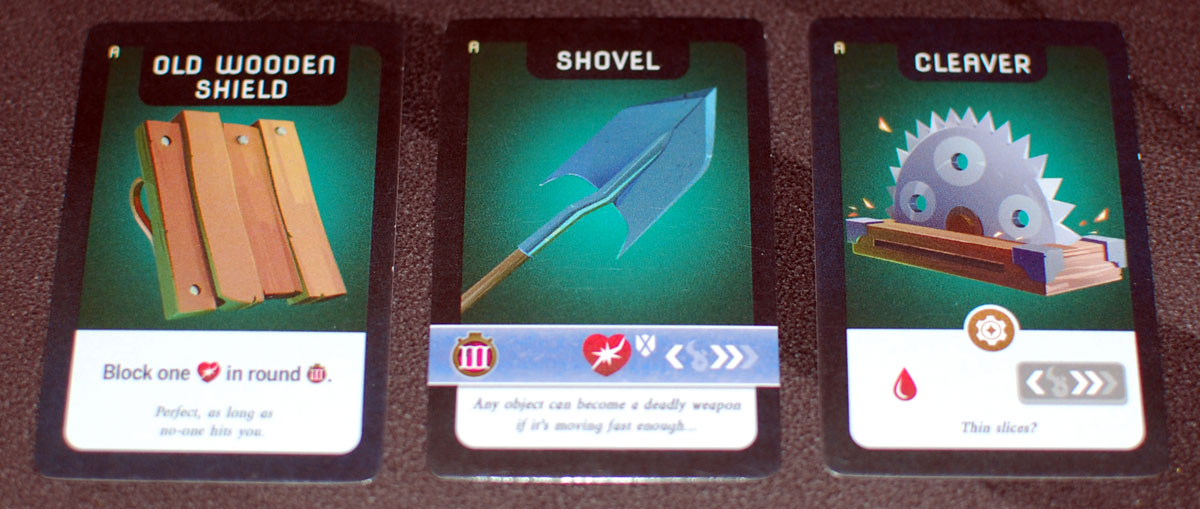
Fans of the video game will have fun recognizing the various enemies and collecting the runes and equipment, even if they don’t all behave exactly the same as they do in the video game. You get to rediscover the paths to the various bosses, and (if you’re like me) find ways to avoid the High Peak Distillery. If you aren’t familiar with the video game, some of the story may be lost on you, because I don’t think the game spends a lot of time spelling out the story for you. The one exception may be the abandoned well, where you can toss extra cells to draw cards. I’ve gone through some of the well but decided not to peek ahead, and the well cards do capture the feel of some of the funny moments and encounters that you have throughout the video game, even though the video game doesn’t have this well at all (as far as I know)!
What’s curious about Dead Cells is the way that your group makes progress and advances through the campaign through failure. Sure, if you keep winning fights, you’ll earn money and put more items into the equipment deck: each biome has its own deck of blueprints and once you’ve acquired them, they’re now permanently in the equipment deck for future runs, so the overall deck is improved. But the big advancements come from spending cells on those upgrade decks, and you don’t get to do that until you lose a fight. There are some paths that are just locked until you find the right rune or unlock a particular mechanic—again, you can’t get them on your first run-through, so you have to die and repeat, hopefully getting a bit further each time.
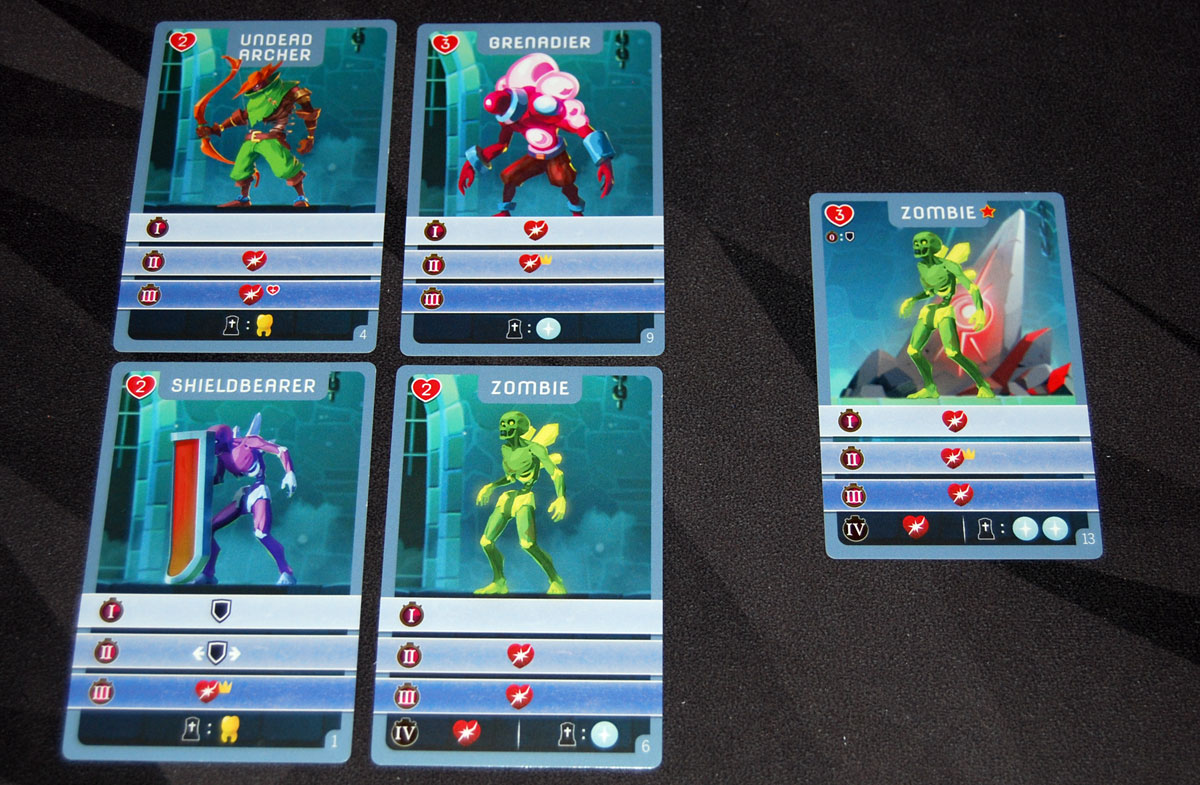
Since the pre-production copy that I was loaned only had the first few biomes, I haven’t gotten to play through the entire campaign yet, but I’m looking forward to giving it a shot in the future. Plus I gotta get to the bottom of that well!
For more information about Dead Cells: The Rogue-Lite Board Game, visit the official website.
Click here to see all our tabletop game reviews.
![]() To subscribe to GeekDad’s tabletop gaming coverage, please copy this link and add it to your RSS reader.
To subscribe to GeekDad’s tabletop gaming coverage, please copy this link and add it to your RSS reader.
Disclosure: GeekDad was loaned a pre-production copy of this game for review purposes.
